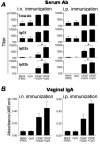Intranasal immunization with chlamydial protease-like activity factor and CpG deoxynucleotides enhances protective immunity against genital Chlamydia muridarum infection
- PMID: 17349723
- PMCID: PMC2757645
- DOI: 10.1016/j.vaccine.2007.02.010
Intranasal immunization with chlamydial protease-like activity factor and CpG deoxynucleotides enhances protective immunity against genital Chlamydia muridarum infection
Abstract
We have reported recently that intranasal (i.n.) vaccination with chlamydial protease-like activity factor (CPAF) and interleukin-12 (IL-12) enhances protective immunity against genital chlamydial challenge. In this study, we show that i.n. or intraperitoneal (i.p.) vaccination with CPAF plus CpG deoxynucleotides (CpG), an alternative T helper 1 (Th1) adjuvant, induced robust CPAF-specific IFN-gamma responses and elevated levels of serum antibody and vaginal IgA production. CPAF+CpG vaccinated animals displayed accelerated genital chlamydial clearance, and minimal hydrosalpinx and inflammatory cellular infiltration compared to mock-immunized (PBS) challenged animals. Together, CpG dexoynucleotides are an efficacious alternative Th1 adjuvant with CPAF to induce protective anti-chlamydial immunity.
Figures




References
-
- Brunham RC, Rey-Ladino J. Immunology of Chlamydia infection: implications for a Chlamydia trachomatis vaccine. Nat.Rev.Immunol. 2005;5(2):149–61. - PubMed
-
- Pirbhai M, Dong F, Zhong Y, Pan KZ, Zhong G. The secreted protease factor CPAF is responsible for degrading pro-apoptotic BH3-only proteins in Chlamydia trachomatis-infected cells. J.Biol.Chem. 2006;281(42):31495–501. - PubMed
Publication types
MeSH terms
Substances
Grants and funding
LinkOut - more resources
Full Text Sources
Other Literature Sources
Miscellaneous

